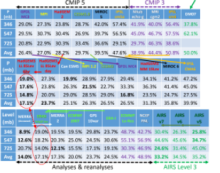GNSS RO, CMIP6, AIRS, ECWMF and GFS Water vapor histograms Comparisons and Implications
E. Robert
Kursinski
PlanetiQ
Poster
We have extended our examination of the hydrological cycle and our understanding of it by comparing low latitude, free tropospheric specific humidity histograms derived from COSMIC and COSMIC2 with those derived from ECWMF and GFS forecasts, AIRS version 7 Level 3 products and CMIP6 climate models.
We examined a number of CMIP6 models including HadGEM3, the CanESM5, MPI 1.2, CESM2, GFDL MC4, MIROC 6 and IPSL CMA6. In terms of water vapor histograms, the CMIP6 models are better than CMIP5 models although at certain pressure levels they can be worse. For daily output, no single model is best at the three different pressure levels we examined.
AIRS v7 is significantly better than versions 6 and 5 in the lower free troposphere but not as good as any of the high resolution analyses and reanalyses we examined. Version 7 is worse in the upper troposphere.
We quantified the dependence of the performance of the histograms on the temporal resolution of the output. Histograms from 6 hour averaging are only slightly worse than those from 1 hour averaging. However, 24 hour averaging does significantly degrade the histograms due to smoothing out the humidity extremes.
One surprise in our results is the specific humidity histograms from the 6 hour HadGEM3 AMIP run for 2007 with specified SST, which have not assimilated any observations, are as close the GPS RO derived histograms as are the 1 hour ERA5 reanalyses for 2007 which have assimilated an enormous number of observations.
We also note that in deriving the COSMIC-2 water vapor data set and histograms, we ran into a subtle problem where the error deconvolution of the histograms from our initial set of retrievals produced an unphysical spike in the driest bin. This was due to a subtle bias associated with using NWP pressure information. When we derived pressure minimizing the use of NWP information, along the lines used in the JPL RO processing system, the problem went away. This indicates the bias in carefully processed Direct water vapor retrievals is less than 0.03 g/kg, consistent with the estimate of Kursinski and Gebhardt (2014).
Two manuscripts on these results will be submitted shortly as part of a GVAP special issue.
We examined a number of CMIP6 models including HadGEM3, the CanESM5, MPI 1.2, CESM2, GFDL MC4, MIROC 6 and IPSL CMA6. In terms of water vapor histograms, the CMIP6 models are better than CMIP5 models although at certain pressure levels they can be worse. For daily output, no single model is best at the three different pressure levels we examined.
AIRS v7 is significantly better than versions 6 and 5 in the lower free troposphere but not as good as any of the high resolution analyses and reanalyses we examined. Version 7 is worse in the upper troposphere.
We quantified the dependence of the performance of the histograms on the temporal resolution of the output. Histograms from 6 hour averaging are only slightly worse than those from 1 hour averaging. However, 24 hour averaging does significantly degrade the histograms due to smoothing out the humidity extremes.
One surprise in our results is the specific humidity histograms from the 6 hour HadGEM3 AMIP run for 2007 with specified SST, which have not assimilated any observations, are as close the GPS RO derived histograms as are the 1 hour ERA5 reanalyses for 2007 which have assimilated an enormous number of observations.
We also note that in deriving the COSMIC-2 water vapor data set and histograms, we ran into a subtle problem where the error deconvolution of the histograms from our initial set of retrievals produced an unphysical spike in the driest bin. This was due to a subtle bias associated with using NWP pressure information. When we derived pressure minimizing the use of NWP information, along the lines used in the JPL RO processing system, the problem went away. This indicates the bias in carefully processed Direct water vapor retrievals is less than 0.03 g/kg, consistent with the estimate of Kursinski and Gebhardt (2014).
Two manuscripts on these results will be submitted shortly as part of a GVAP special issue.

Poster PDF